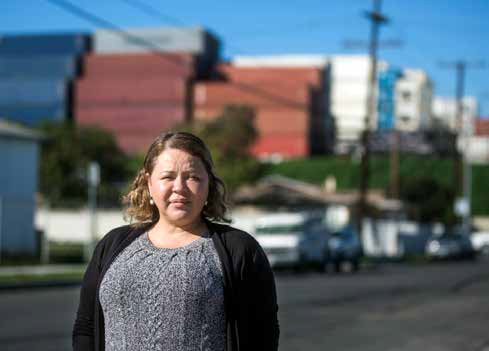
Too Dangerous & Risky
Between fires and smog days, gas plants suck the life out of the frontline communities who live near them. Gas is anything but ‘natural.’ It is a processed fossil fuel with many serious short-term and long-term dangers to public health, safety, and the climate.
The majority of California’s polluting gas-fired power plants are near working families and communities of color
- According to the environmental justice screening tool CalEnviroScreen 3.0., half of California’s gas power plants are located in communities that rank among the 25% most disadvantaged.
- Currently, twenty-eight natural gas plants in California could be retired while still meeting energy and reliability requirements. Twelve of these are located in communities disproportionately burdened by air pollution and should be retired, while prioritizing investments in growing our clean energy economy in front line communities.
- The Inland Empire, which already suffers from high levels of poverty and the worst air pollution in the nation, has three of the dirtiest gas plants in the state — all three in the city of Colton.
- Oxnard’s beaches are lined with smokestacks, with three power plants on its coastline — more than any other city in California, and already has to contend with oil field pollution and a coastal Superfund site near homes.
Drilling, extraction, and operation of gas puts families in danger
“Renewables and demand response and batteries
are about to do to gas what gas has done to coal.”
— Mark Dyson, Rocky Mountain Institute
- From 2010 to 2016, gas companies reported 35 explosions and 32 ignitions at their transmission pipelines.
- In 2015, SoCalGas was responsible for the Aliso Canyon gas leak disaster with 111,000 pounds of methane escaping every hour, pumping cancer-causing benzene into the air. It was the largest recorded gas leak in state history, and the worst in U.S. history in terms of environmental impact. Reports stated it was even more damaging than the infamous 2010 BP Deepwater Horizon spill and the 1989 Exxon Valdez oil spill.
- Gas is explosive by nature. The San Bruno explosion of 2010, which killed 8 and injured dozens more, are tragic reminders of this.
- Drilling for gas also increases concentrations of hazardous air pollutants, particulate matter, and ozone plus its precursors, in nearby communities.
- Shale gas extraction and hydraulic fracturing is particularly dangerous as residents living near wells are at greater risks for harmful health effects.
- The extraction of gas also leads to permanent loss of water. Fracking fluid — needed for hydraulic fracturing — is 90% water.
The gas industry likes to say gas is the most “reliable” energy source for the grid. But what’s so reliable about a product that is flammable, can cause explosions, and is a finite resource that will go the way of coal as we shift more towards renewables and energy efficiency?
“Too many Californians, especially low-income families, breathe in unhealthy air that causes senseless suffering and robs us of long life.”
—Magali Sanchez-Hall, Wilmington Leader at Communities for a Better Environment
Costly, Wasteful, and Unnecessary
Gas isn’t going to get cheaper. Meanwhile, renewable energy and energy efficiency is in many cases now cheaper than gas, and will continue to get cheaper. A new study from the Rocky Mountain Institute found that by 2035, it will be more expensive to run 90% of gas plants being proposed in the U.S. than it will be to build new wind and solar farms equipped with energy storage.
Across California, municipalities are recognizing that we don’t need gas plants to meet their needs, as they will only grow increasingly wasteful.
Gas Stands Against California’s Climate Goals
- SB 100, the landmark bill signed into law by Gov. Brown in 2018, commits California to completely ditch fossil fuels by 2045. When it comes to California’s progress to meet this goal, gas stands in the way.
- Gov. Newsom’s FY19-20 budget included $165 million in funding over five years for California’s Workforce Development Board for targeted career apprenticeship programs with a focus on workers in areas like Kern County to help fossil fuel workers transition to high paying, clean economy careers. A clean energy economy without gas plants
A more sustainable, safer, and healthier future for California families.
- A study by the Department of Energy’s National Renewable Energy Laboratory has demonstrated that renewable technologies that are commercially available today, combined with a more flexible electricity system, could affordably and reliably provide 80 percent of U.S. electricity needs by 2050. This means that, with rapidly evolving renewable technologies, and especially investments in clean energy storage, 100 percent of U.S. electricity needs can definitely be met by 2045.
- Alternatives to gas plants will be better for communities economically and environmentally, delivering high paying jobs in industries that are flourishing, not fading. We need to adequately fund these workforce development programs to meet the scale of our climate crisis.
“‘Should we build that new peaker?’ The answer is going to be no, we have another option.”
— Scott Smith, leader of the U.S. Power and Utilities National Sector, Deloitte

